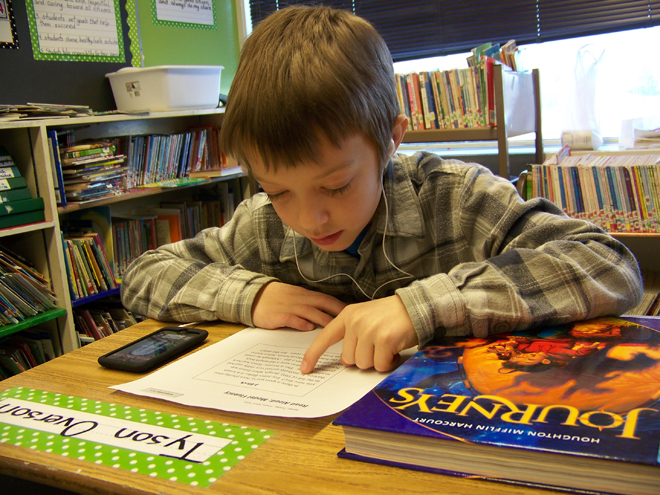By McKibben Jackinsky
Staff writer
When Chapman School Principal Conrad Woodhead heard a presentation last year by Rep. Paul Seaton, R-Homer, on the benefits of using Apple’s iPod Touch in classrooms, he wanted to know more.
For starters, Woodhead is always eager to improve learning opportunities for Chapman’s pre-kindergarten through eighth-grade students. Secondly, Seaton’s presentation to the Kenai Peninsula Borough school board referred to the use of iPods in Oregon’s Canby School District.
“My ears perked up because that’s the school district I grew up in,” said Woodhead.
The Canby School District has been using the Apple-manufactured pocket computers for several years. A 2011 presentation prepared by Joe Morelock, Canby’s director of technology and innovation, reflects increased student performance in math and reading in elementary grades since the iPod Touch was introduced.
Seaton, former chair and current member of the House Education Committee, met Morelock at the Association of Alaska School Board’s annual conference and had an opportunity to review and discuss Canby’s findings.
Students use iPods to study math, learn to read and improve English fluency. Studies on iPod usage suggest they enhance learning by making it fun and by helping students concentrate.
A YouTube video of iPod usage at Central Elementary School in Escondido, Calif., shows students working on their reading and math skills. According to Kathy Shirley, technology and media director for the Escondido School District, in a six-week period of time, students showed fluency gains four to six times more than what was considered normal for that period.
Convinced “this was something that would really accelerate education in our district,” Seaton met with Apple representatives and expressed his interest in introducing iPods in peninsula classrooms. He reached an agreement with Apple to loan 40 iPod Touches to the district on a trial bases.
When Seaton presented that opportunity to the district, however, the district decided to purchase enough iPods for one classroom for the 2011-2012 spring semester.
“KPBSD conducted a pilot project last year that included both iPods and iPads,” said Pegge Erkeneff, KPBSD communications specialist. “Schools that participated in the pilot were selected based on data and demographics.”
Seventy-four students took part in KPBSD’s Apple iPod Reading Fluency Pilot Project, including second-graders at Mountain View and Soldotna elementary schools, second- and third-graders at Razdolna School, and second- through fourth-graders at Nikiski North Star School. Fifth-graders took part in KPBSD’s Apple iPad Reading Comprehension and Math Measurement Pilot Project at Redoubt Elementary School.
“One of my goals was that with iPod Touches with headsets, students would go ahead and check them out. They’re small enough that they won’t get broken,” said Seaton.
“On the bus ride home, students would extend their school day because they’d want to play the math and language games on them. They also allow kids to advance at their own speed, so they’re not doing something they already know really well.”
Woodhead also did his iPod homework. While visiting in the Canby area last summer, he met with Canby School District personnel to discuss their experience with iPods and the difference it made in students’ test scores. He also let Seaton know he and Chapman teachers were interested in introducing iPods at Chapman.
For the 2012-2013 school year, other sites were added to the iPod program due to funding secured by Seaton, said Erkeneff. Included were first-grade students at Paul Banks Elementary School, fifth-grade students at West Homer and McNeil Canyon elementary schools and all of Chapman with the exception of kindergarten. The benefit of including an entire school is that “when you have a whole school, you can see how much they’ve increased in their proficiency from one year to the next,” said Seaton.
The iPod project will be evaluated using benchmark testing scores and Standards Based Assessment, teachers’ documentation, and student and staff surveys to be conducted in the spring, said Erkeneff.
“Whether we like it or not, we can’t run from technology, so the purpose is not to replace anything we’re doing in the classroom — reading, writing, math, that kind of thing. We’re exposing all of our kids equally to technology they might otherwise not be exposed to,” said Woodhead.
Woodhead also sees the possibility of extending the teaching day, as Seaton had noted, by allowing students to take iPods home.
“Right now, I want to make sure we walk before we run with these products,” said Woodhead. “People are still learning their capabilities
Two Chapman students — student body president Jake Roberts and vice president Laila Isaac — showed off just how much they’ve learned by preparing on
iPods Woodhead’s presentation at Monday’s meeting of the Kenai Peninsula Borough school board.
“They were able to make a video, take pictures and piece it together in a visual communications class,” said Woodhead. “It was pretty cool.”
McKibben Jackisky can be reached at mckibben.jackinsky@homernews.com.


